|
Taybern Equipment Company "Mystery Radio" |
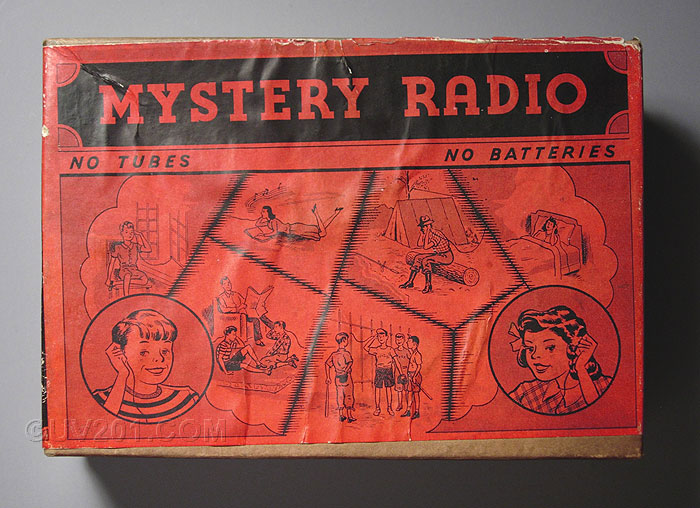 |
| This is the
Mystery Radio made by the Taybern Equipment Corporation of New York City, and was
produced just after WW-II. I found a "business opportunities" ad in the July 1949 issue of Popular Science magazine which read: "Excellent sideline, Mystery Radio, no tubes, no batteries, no electricity. Retails $2.98, Literature available. Sample $2.00. Diacin Incorporated. 12800 Plymouth, Detroit Michigan" The Mystery Radio is a crystal set, meaning the detector is a crystal diode, which converts the radiated energy from a radio station to an audio signal that can operate an earphone. In this one, there is nothing more than the diode and the earphone. There is no tuning adjustment whatsoever. If you were close to a radio station (or you had a good antenna), you would be able to hear it with this device. Unfortunately, if there happened to be more than one strong station in the area, you might hear all of them at once. Taybern listed their address as 120 Greenwich St. in lower Manhattan. This was a 13-story commercial building only a few blocks from where the World Trade Center would later be built. This part of Manhattan was the location of the famed NY "Radio Row" that was all but obliterated to make room for the Trade Center. The building now houses a number of pricey condominiums (selling for about $1,000/sq. ft). Interestingly, the "Exclusive U.S. Distributor" is listed on the box, the Diacin Chemical Company of Detroit, but that Plymouth Rd. address turns out to have been nothing more than a place called Stern's drug store. Today, that location is the parking lot of a trashy liquor store. A document available from the National Institute of Health archive shows Diacin had gotten into a bit of difficulty in 1951 for selling 20,000 barbiturate capsules in Cleveland at a lesser strength than was claimed. It would appear that Diacin was nothing more than a side enterprise of Stern's drug store. Were they buying drugs in bulk from manufacturers, cutting them, and then reselling them to other outlets, or simply lying about what they were selling? Either possibility could be the case. As for the radio itself, many companies sprung up just after the war seeking to profit from the flood of electronic surplus that came into the civilian market. Taybern appears to be one of them, but I am not aware of any other products that they made. They modified a military earphone by adding a surplus 1N21 microwave mixer diode which they concealed inside the earphone housing. The external wiring was a length of standard AC line cord, with clips on the end. The listener would have clipped one wire to an antenna (or any ungrounded metallic structure) and the other wire to an actual ground. There does not appear to have been any clip or other device to hold this unit to the ear. Each of the listeners shown on the front of the box are holding the radio to their ears. The earphone unit is only about 7/8 inch in diameter, and 1 1/4 inch long. A fellow collector was kind enough to send me a scan of an original instruction sheet for the Mystery Radio, which appears below. It's interesting that they suggested that a sixty mile reception was possible with this radio, but weren't willing to guarantee even five mile reception! |
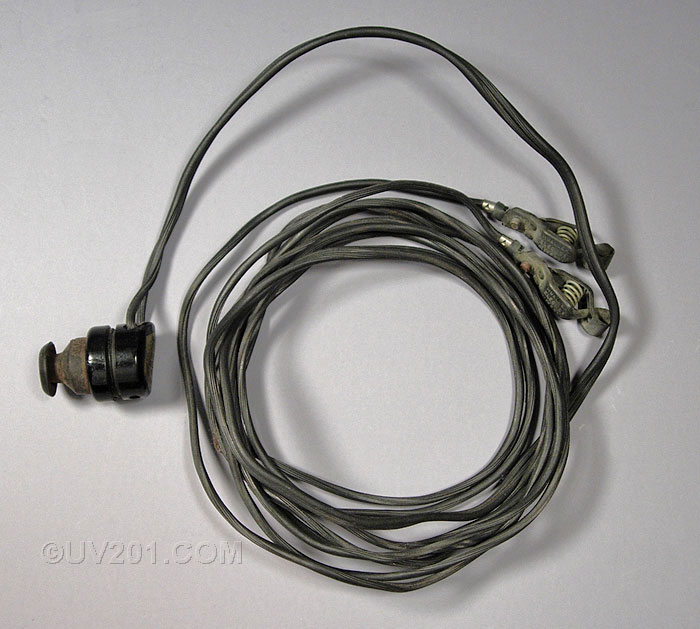 |
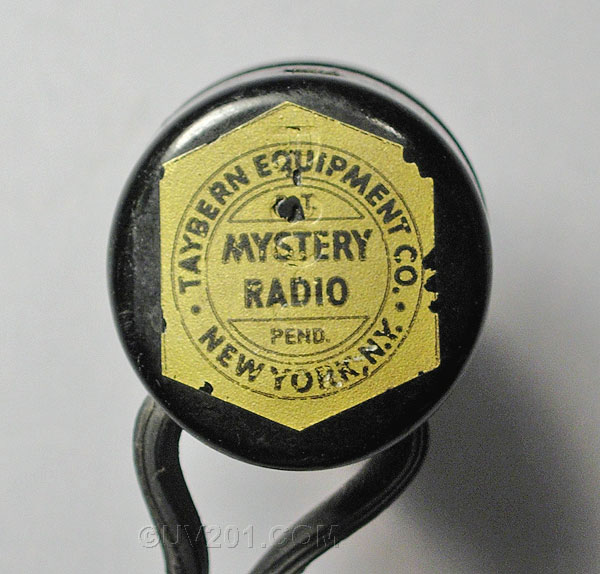 |
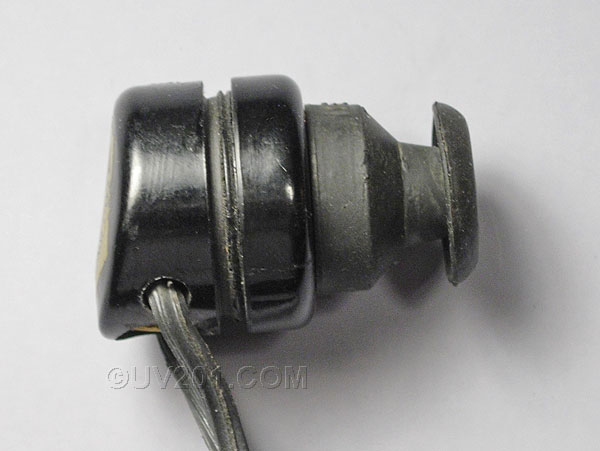 |
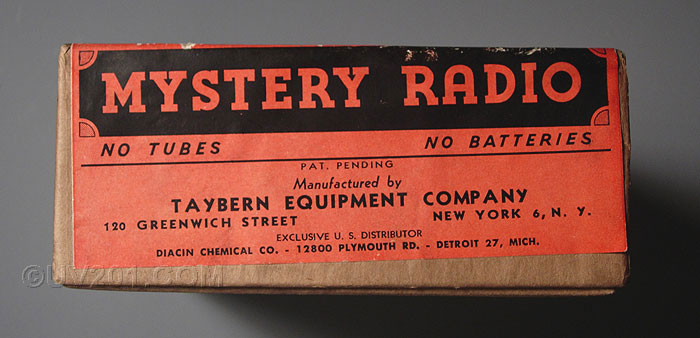 |
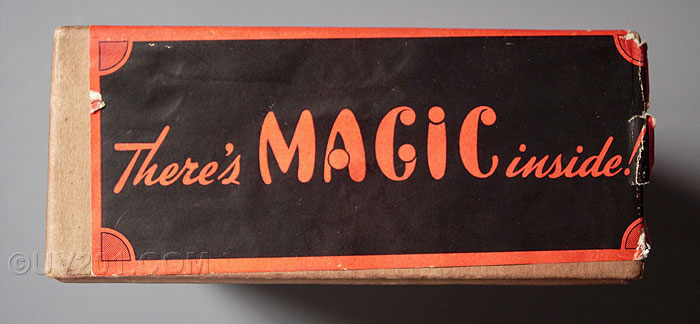 |
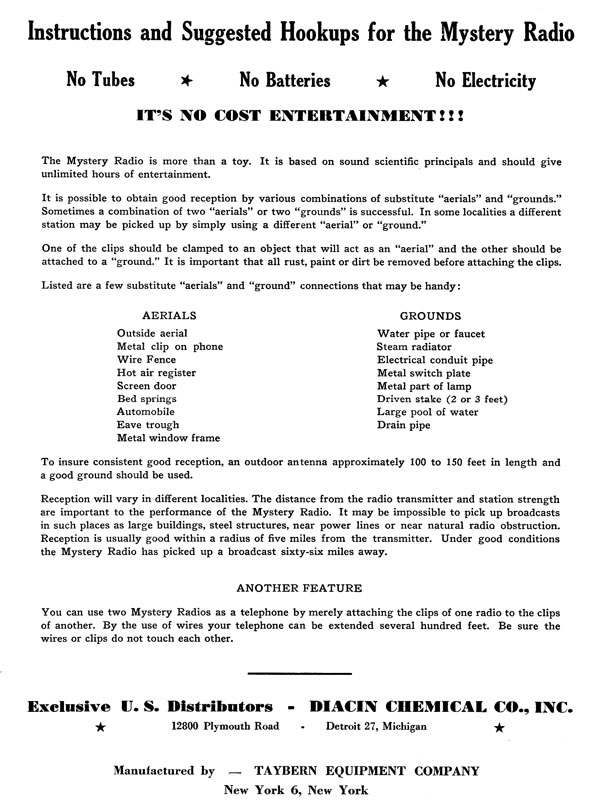 |
| A site visitor was kind enough to send me an email describing his experiences with the Mystery Radio many years ago. I am (with his kind permission) presenting it here, with just a bit of editing. His recollection of paying $0.25 for his radios speak to a time at which transistor radios were flooding in from Japan at ever decreasing prices. |
|
I want to thank you for posting the pictures of this device. I had such a thing when I was about 12-13 years old living on the west side of Detroit over 45 years ago. I in fact, rode my bicycle about a mile to the Plymouth location that was at the 12800 address. I paid 25¢ for it, rode back home with great anticipation and an imagination to boot. It was one of the few products that held my attention. I had bought three others after discovering you could connect them together and use them like a telephone. You seemingly are pretty harsh in what you posted; a radio as we know it by today's standards, no, I agree. But for this young boy back in the day with a huge imagination, (something lacking in today's children) it truly was a Mystery Radio. I could hear all kinds of stations, all kinds of music, and each one of them seem to have a different station that would be strongest. Transistor radios were not commonplace at that time, and were a bit costly until 65-66 rolled around and technical advancement and Japanese mass production did the cost come down for me as a teenager then, could afford to buy one at the cost of $2.98; had to cut a lot of lawns for that radio. It is funny, I posted a story about this very item on my facebook page, and for kicks and grins, I did a search and lo and behold, your site popped up and I got to see the very item that gave me some fond memories connected to it all for 25¢...what a buy. Sure wish I had one of the four I did back then. All so many stories connected to this item, all so many fun things we did with the Mystery Radio. Thanks again for posting the pics, they back up my lengthy story I had posted. Respectfully, A Mystery Radio owner and operator. Oh by the way: the address of the Diacin Chemical Company - 12800 Plymouth Rd. - Detroit, 27, Michigan - Being the Exclusive U.S. Distributor; was actually a corner drug store that sold them outright to the public and mail order as advertize in comic books and other periodicals [?] if I recall correctly. Of course being Detroit, the place is long gone building and all; an empty lot where my adventure had began but my fond memories remain.
|